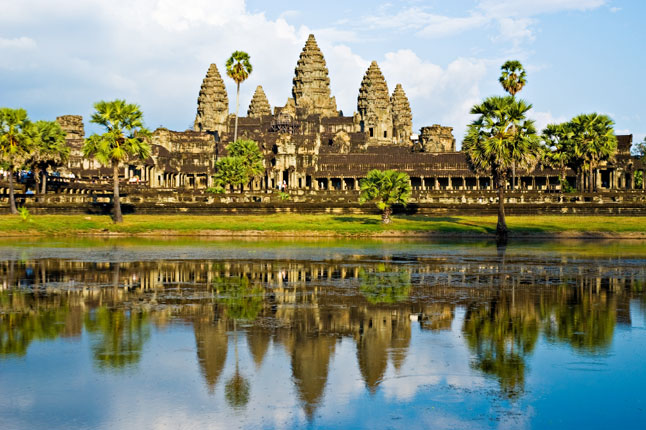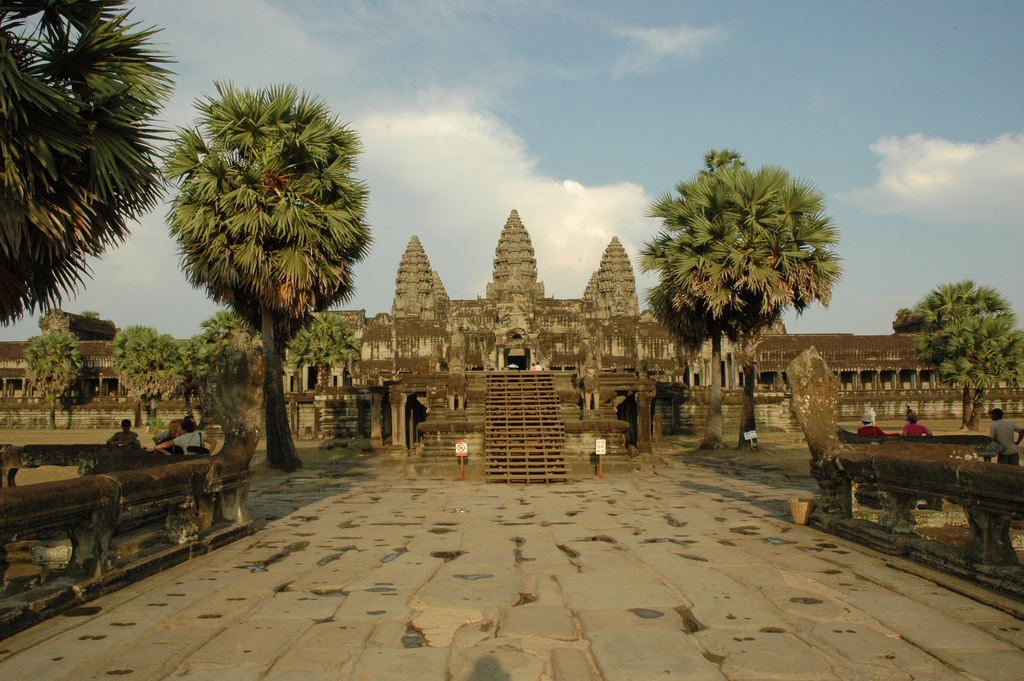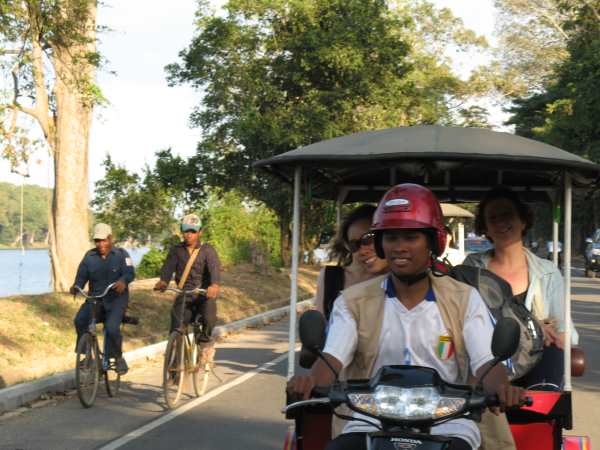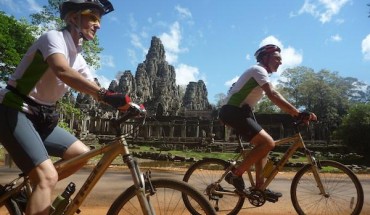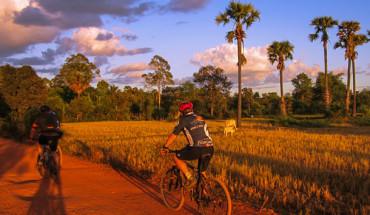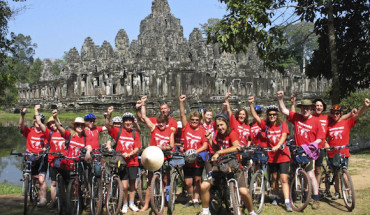The ruins of the ancient city of Angkor, capital of the Khmer kingdom from a. d. 802 until 1295, are one of the world’s marvels. The “City of Kings,” Angkor boasts some of the largest religious monuments ever constructed; it’s a vast and mysterious complex of hulking laterite and sandstone blocks.
Unknown to the world until French naturalist Henri Mouhot literally stumbled onto it in 1861, the area of Angkor existed for centuries only as a myth-a wondrous city (or cities, to be exact), its exact location in the Cambodia jungle unknown. After Mahout in 1861, archaeologists flocked here, only to be foiled by years of conflict that left the temples in the hands of the Khmer Rouge. Many temples were damaged and pillaged. Tourists were the subsequent invaders, from the late 1990s. Today the sight is mobbed, but you can still find those quiet moments in communion with this amazing man-made wonder.
The temple complex carries the remains of passageways, moats, temples, and palaces that represent centuries of building in the capital. Days spent scrambling about and exploring the temples are memorable, and this is a great place to bring adventurous kids who like to get their play clothes dirty.
The temples are served by the nearby town of Siem Reap, some 6km (3,75 miles) to the south. Siem Reap means “Victory over the Thais” and refers to the 16th-century victory that solidified the Khmer kingdom though animosity between the two neighbors remains to this day. All of western Cambodia was once under Thai control, and Khmer people are very proud of their survival in the face of so many invaders, the very reason that an image of Angkor Wat graces the national flag.
Siem Reap, once just a dusty track with a few storefronts, now supports a host of large five-star hotels and resorts, fine-dining options aplenty, and the kind of good services, shops, galleries, and spas that make the little city a new oasis of luxury in parched western Cambodia. The town’s central market is a great stop for souvenir purchases, and the nearby downtown area is abuzz day and night with fine-dining options and quaint bars and party spots.
A 3- day or 4-day visit will suffice (though many do it in less time) to come away with a newfound love for ancient cultures, Asian religions, and sunsets. Good options abound for visiting more far-flung temple ruins (in fact, one of the most common complaints is about the large crowds that now visit Cambodia’s “Disneyland of Temples”), and trekking or boat trips to remote mangrove swamps and a large bird sanctuary are enough to keep you busy. Bring your sense of adventure, your camera, and a youthful sense of wonder. You won’t be disappointed by amazing Angkor.
Getting There
By plane Bangkok Air (in Phnom Penh: 023/426-624; in Siem Reap: 063/ 380-191; www.bangkokair. com) is currently the only airline running the 1-hour connection to Siem Reap from Phnom Penh. If you just want to see the great temples at Angkor, the process is simplified with international arrivals: Vietnam Airlines flies directly from Ho Chi Minh City, Bangkok Airways flies directly from Bangkok, and you can check flights by Silk Air and Lao Avia lion lor other routes.
I highly recommend flying into town. The international airport is relatively new and beautifully designed, using traditional Cambodian architecture. BY BOAT A ride on the 5-hour boat connection between Phnom Penh and Siem Reap. Contact any hotel or travel agent (they all sell the same tickets at the same price). The scenic trip connects to Siem Reap via the great Tonle Sap Lake. Siem Reap also connects with Battambang, to the south and west, via the Tonle Sap and the Sangker River. The trip shows you life in fishing villages along the river as you trace the banks of the Sangker. In the rainy season, the ride is 6 to 8 hours, but in the dry season (Feb-May) it can take 8 to 10 hours or more and isn’t recommended. Book your ticket at any tour agent or your hotel or guesthouse.
A new option is the weeklong cruise between Angkor Wat and either Can Tho or My Tho in Vietnam’s Mekong Delta aboard one of the luxury, shallow-draft Pandaw Cruise Boats (www. pandaw. com).
By bus Your hotel front desk can arrange bus transportation for you at no additional cost. Mekong Express (023/427-518) connects Phnom Penh and Siem Reap with daily luxury buses. Bus rides come with water and an edible snack, and there’s a bathroom on board. Tip: A set of earplugs is your friend on this bus ride (and any bus ride really), as they play Khmer karaoke songs and various Asian pop music videos. Capitol Tour (No. 14 Road 182; 023/217-627) also runs daily mini vans between Phnom Penh and Siem Reap, as well as to destinations farther afield such as Battambang or Poipet at the Thai border. Neak Krorhorm Travel and Tour (in Phnom Penh, 023/219-496; and in Siem Reap near the Old Market, 063/964-924) provides similar services.
Getting around
You’ll need some kind of wheels to make your way around Siem Reap and to and from the temples. Any hotel front desk or travel agent can make arrangements for you.
A rented car with driver is about $25 (double that with a guide). This is your best bet if hitting the temples farther afield, but if just doing the main temple circuits, I recommend one of the open-air options below.
Tuk-tuks are the best choice and available anywhere. The name is taken from the Thais, but these tuk-tuks have nothing to do with the noisy Bangkok three-wheeler. These are a two-wheeled surrey pulled by a standard motorbike. They are shaded, and the padded seat is great for two. There’s a small shelf at the front of the cart, usually with laminated maps and advertisements, and, in a pinch, you can seat two more, but it’s not very comfy.
A motorcycle taxi, called a motodup, is a good. Helmets are generally available, though few wear them (I recommend wearing one). This is a good choice for solo travelers going to the temples without a guide. For sights farther afield, it can be a bit tiring. If going way out, ask for a helmet with a wind screen, as it’s safe and saves a day of squinting. Riding your own motorbike was once the most popular choice, but local officials put a stop to it, citing many road accidents.
The temple roads are flat and well paved, so bicycles are a popular choice. You can rent one day from guesthouses and hotels lake care in the scorching midday heat, and drink plenty of fluids. On a bike, you can go where you please, as you please. When parking at temples, vendors implore you to park near them and they’ll mind your bike. Agree to nothing, but tell them that maybe you’ll buy something later; when you do need the inevitable bottle of water, buy from your new friend.


